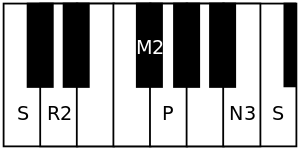Raaga : Hamsanadam
Hamsanadam (pronounced hamsanādam) is a rāgam in Carnatic music (musical scale of South Indian classical music). It is a pentatonic scale (audava rāgam, which means "of 5"), as it is sung in current days.[1] It is a derived scale (janya rāgam), as it does not have all the seven swaras (musical notes), from the 60th Melakarta rāgam Neetimati.[1]
Structure and Lakshana[edit]
Hamsanadam, as it is sung now-a-days, is a symmetric scale that does not contain gandharam and dhaivatam. It is called an audava rāgam,[1] in Carnatic music classification (as it has 5 notes in both ascending and descending scales). Its ārohaṇa-avarohaṇa structure is as follows (see swaras in Carnatic music for details on below notation and terms):
This scale uses the notes shadjam, chatusruti rishabham, prati madhyamam, panchamam and kakali nishadam.
Other structures[edit]
- Ascending scale : S R2 M2 P D3 N3 S
- Descending scale : S N3 D3 N3 P M2 R2 S
In the above, shatsruti dhaivatam is added in the scale compared to current usage (shadava scale with 6 notes in ascendinga and descending scale), with a vakra prayoga (zig-zag descending scale).[1][2]
Popular compositions[edit]
Hamsanadam has a few popular compositions:
- Bantureethi Kolu by Tyagaraja
- Niye Paramukham by Papanasam Sivan
- Kripanidhe by Muthiah Bhagavatar
- Kalyana Rama by Oothukkadu Venkata Kavi
- Pada Vendume by Dandapani Desikar
- Bharama Ee Baluni by G N Balasubramaniam

Comments
Post a Comment